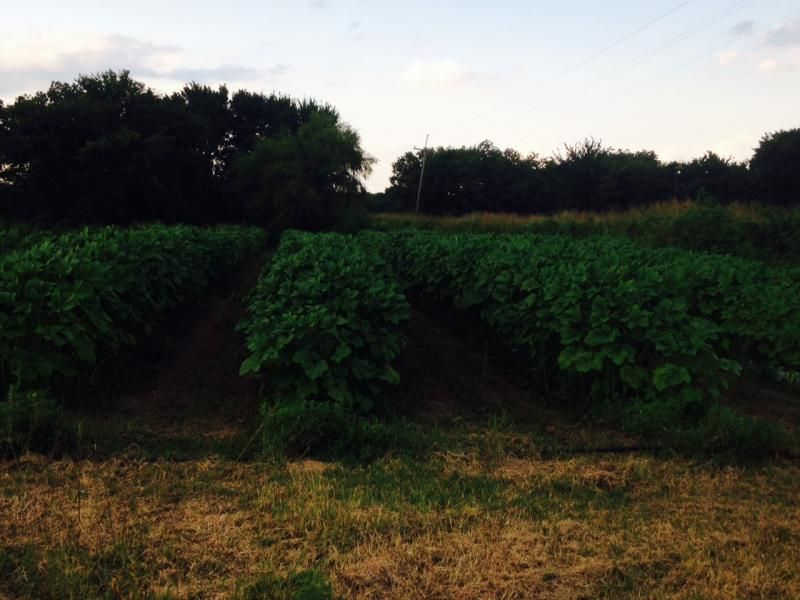Post by Fourteenmilecreek on Sept 8, 2013 14:55:15 GMT -6
You may have heard of Heavy Hitter okra over the past few years, as I have been speaking of it in seminars presented by Oklahoma State University, and the Oklahoma Department of Agriculture, for a few years now.
Heavy Hitter is a new strain of okra developed on Dry Creek Farm, from a variety called Clemson Spineless. The original Clemson Spineless seeds were passed down to me from Fannie Darrow of Hulbert, Oklahoma in 1972. This had been her lifelong favorite variety. she was born in 1898, and had been gardening since she was old enough to get out there with her mother in the early 1900s.
As the years went by, I saved seeds from these Clemson Spineless plants at random (returning random results). At that time, I only had a small garden in the back yard about 20' feet by 20' feet square. The original Clemson Spineless seeds would grow single stalk specimens, averaging 14 pods per season. In 2004 I noticed a single plant which had produced 54 pods over the course of the season. At that point, I stopped harvesting okra from that plant, and allowed the remaining few pods to mature into seed stock for the 2005 gardening season.
In early May of 2005, I planted seeds from that single plant that had grown 54 pods on a single stalk in 2004. I planted it in a separate location (far away from the rest). I was teaching Science at Chouteau High School that year, and needed a classroom experiment to come back to when school was in session the next Fall. When the 2005 growing season had come to an end and I found that plants grown from those seeds had produced so heavily. I knew I was on to something!
In 2006, seeds I saved from this line produced even more heavily, producing stalks with as many as three branches. That season, I only harvested seeds from stalks with three branches, and 50 or more pods.
In 2007, some of the stalks produced 5 to 7 branches, and were also heavy bearing. That season, I only saved seeds from stalks bearing seven branches, and more than 50 pods.
In 2008, I expanded my garden to 30' feet by 75' feet; concentrating most of my efforts on okra production. Many of the seeds from this line bore 12 or more branches (all branches bearing crowns of blooms that became tender okra pods, each branch bearing an average of 10 pods). I harvested 600 pounds of okra that year. Sales at the newly founded Tahlequah Farmers' Market fostered my gardening expenses, making that my first profitable year of gardening.
In 2010, I expanded my garden to 50' feet by 150' feet. I harvested over 1,100 pounds of okra, causing me to expand my market to include Reasor's grocery store, Food For Less grocery, Oasis Health Food Store, Tahlequah Farmers' Market, occasional tailgate sales, and sales to several area restaurants.
By 2011, I had groomed, and culled this line of seeds until at last, one of them bore 65 branches (each sporting blooms and several pods). By the end of that season I had harvested over 350 pods from one plant. On my record day, I harvested 44 tender pods from this one plant. For that reason, I named this new Strain, 'Heavy Hitter'.
However, an unexpected, early, killing freeze the first week of October of that year, brought sustained temperatures of 21 degrees for more than six hours, killing almost all the seeds, before maturity. Only five pods survived to seed saving quality. (A good lesson was learned that year, "One should plant valued seeds in more than one location to help insure continuation of that seed's line").
2012 was just as severe... Record breaking drought, and high temperatures, coupled with deer depredation, wild fire, and an unprecedented explosion in the local grasshopper population, would almost certainly have destroyed all my years of effort, had I not 'farmed out' seeds to other locations, via farmers in Oklahoma City, and Bixby. These friends of mine saving seeds in locations that were hundreds of miles apart are the only reason I still have seeds from the 'Heavy Hitter' line.
Today, I have a garden that is 100' feet by 177' feet. I have seeds from my Heavy Hitter line growing in Mineral, Virginia - Liberia, Africa - Oklahoma City, Oklahoma - Perkins, Oklahoma - Tahlequah, Oklahoma, Stillwater, Oklahoma - Delta State, in Mississippi, and at Louisiana State University. (My thanks to Oklahoma State University, as they have been very instrumental in helping me preserve this line since 2010).
It is my hope to preserve the characteristics of this heavily bearing strain, by saving seeds, and sharing them across the Nation, and beyond in an effort to help other farmers become more successful in growing produce for their local markets.
![]()
![]()

![]()
![]()
\\\

Heavy Hitter is a new strain of okra developed on Dry Creek Farm, from a variety called Clemson Spineless. The original Clemson Spineless seeds were passed down to me from Fannie Darrow of Hulbert, Oklahoma in 1972. This had been her lifelong favorite variety. she was born in 1898, and had been gardening since she was old enough to get out there with her mother in the early 1900s.
As the years went by, I saved seeds from these Clemson Spineless plants at random (returning random results). At that time, I only had a small garden in the back yard about 20' feet by 20' feet square. The original Clemson Spineless seeds would grow single stalk specimens, averaging 14 pods per season. In 2004 I noticed a single plant which had produced 54 pods over the course of the season. At that point, I stopped harvesting okra from that plant, and allowed the remaining few pods to mature into seed stock for the 2005 gardening season.
In early May of 2005, I planted seeds from that single plant that had grown 54 pods on a single stalk in 2004. I planted it in a separate location (far away from the rest). I was teaching Science at Chouteau High School that year, and needed a classroom experiment to come back to when school was in session the next Fall. When the 2005 growing season had come to an end and I found that plants grown from those seeds had produced so heavily. I knew I was on to something!
In 2006, seeds I saved from this line produced even more heavily, producing stalks with as many as three branches. That season, I only harvested seeds from stalks with three branches, and 50 or more pods.
In 2007, some of the stalks produced 5 to 7 branches, and were also heavy bearing. That season, I only saved seeds from stalks bearing seven branches, and more than 50 pods.
In 2008, I expanded my garden to 30' feet by 75' feet; concentrating most of my efforts on okra production. Many of the seeds from this line bore 12 or more branches (all branches bearing crowns of blooms that became tender okra pods, each branch bearing an average of 10 pods). I harvested 600 pounds of okra that year. Sales at the newly founded Tahlequah Farmers' Market fostered my gardening expenses, making that my first profitable year of gardening.
In 2010, I expanded my garden to 50' feet by 150' feet. I harvested over 1,100 pounds of okra, causing me to expand my market to include Reasor's grocery store, Food For Less grocery, Oasis Health Food Store, Tahlequah Farmers' Market, occasional tailgate sales, and sales to several area restaurants.
By 2011, I had groomed, and culled this line of seeds until at last, one of them bore 65 branches (each sporting blooms and several pods). By the end of that season I had harvested over 350 pods from one plant. On my record day, I harvested 44 tender pods from this one plant. For that reason, I named this new Strain, 'Heavy Hitter'.
However, an unexpected, early, killing freeze the first week of October of that year, brought sustained temperatures of 21 degrees for more than six hours, killing almost all the seeds, before maturity. Only five pods survived to seed saving quality. (A good lesson was learned that year, "One should plant valued seeds in more than one location to help insure continuation of that seed's line").
2012 was just as severe... Record breaking drought, and high temperatures, coupled with deer depredation, wild fire, and an unprecedented explosion in the local grasshopper population, would almost certainly have destroyed all my years of effort, had I not 'farmed out' seeds to other locations, via farmers in Oklahoma City, and Bixby. These friends of mine saving seeds in locations that were hundreds of miles apart are the only reason I still have seeds from the 'Heavy Hitter' line.
Today, I have a garden that is 100' feet by 177' feet. I have seeds from my Heavy Hitter line growing in Mineral, Virginia - Liberia, Africa - Oklahoma City, Oklahoma - Perkins, Oklahoma - Tahlequah, Oklahoma, Stillwater, Oklahoma - Delta State, in Mississippi, and at Louisiana State University. (My thanks to Oklahoma State University, as they have been very instrumental in helping me preserve this line since 2010).
It is my hope to preserve the characteristics of this heavily bearing strain, by saving seeds, and sharing them across the Nation, and beyond in an effort to help other farmers become more successful in growing produce for their local markets.

\\\




